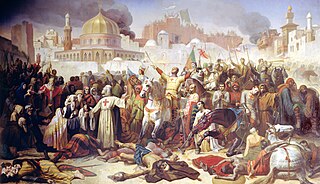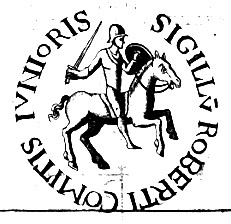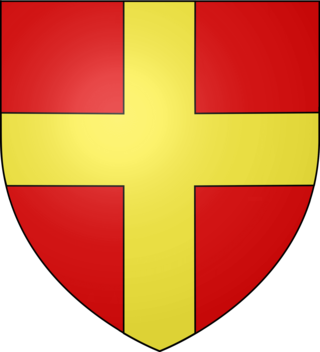Related Research Articles

Year 1099 (MXCIX) was a common year starting on Saturday of the Julian calendar.

Baldwin I was the first count of Edessa from 1098 to 1100 and king of Jerusalem from 1100 to his death in 1118. He was the youngest son of Eustace II, Count of Boulogne, and Ida of Lorraine and married a Norman noblewoman, Godehilde of Tosny. He received the County of Verdun in 1096, but he soon joined the crusader army of his brother Godfrey of Bouillon and became one of the most successful commanders of the First Crusade.

Godfrey of Bouillon was a preeminent leader of the First Crusade, and the first ruler of the Kingdom of Jerusalem from 1099 to 1100. Although initially reluctant to take the title of king, he agreed to rule as prince (princeps) under the title Advocatus Sancti Sepulchri, or Advocate of the Holy Sepulchre.

Baldwin II, also known as Baldwin of Bourcq or Bourg, was Count of Edessa from 1100 to 1118, and King of Jerusalem from 1118 until his death. He accompanied his cousins Godfrey of Bouillon and Baldwin of Boulogne to the Holy Land during the First Crusade. He succeeded Baldwin of Boulogne as the second count of Edessa when he left the county for Jerusalem following his brother's death. He was captured at the Battle of Harran in 1104. He was held first by Sökmen of Mardin, then by Jikirmish of Mosul, and finally by Jawali Saqawa. During his captivity, Tancred, the Crusader ruler of the Principality of Antioch, and Tancred's cousin, Richard of Salerno, governed Edessa as Baldwin's regents.

Robert II, Count of Flanders was Count of Flanders from 1093 to 1111. He became known as Robert of Jerusalem or Robert the Crusader after his exploits in the First Crusade.

The count of Tripoli was the ruler of the County of Tripoli, a crusader state from 1102 through to 1289. Of the four major crusader states in the Levant, Tripoli was created last.

Frisian involvement in the Crusades is attested from the very beginning of the First Crusade, but their presence is only felt substantially during the Fifth Crusade. They participated in almost all the major Crusades and the Reconquista. The Frisians are almost always referred to collectively by contemporary chroniclers of the Crusades and few names of individual Frisian crusaders can be found in the historical record. They generally composed a naval force in conjunction with other larger bodies of crusaders.
Warner of Grez Count of Grez, was a French nobleman from Grez-Doiceau, currently in Walloon Brabant in Belgium. He was one of the participants in the army of Godfrey of Bouillon of the First Crusade, and died in Jerusalem a year after the crusade ended. His brother Henry is also listed as a Count of Grez and accompanied Warner on the First Crusade.
The Counts of Montaigu were 12th century nobles of Lower Lotharingia who were closely associated with the Counts of Duras and Clermont. This particular place called Montaigu was a castle located on the river Ourthe, opposite Marcourt near La Roche in the Ardennes. The castle of Montaigu has been mostly destroyed, but a chapel dedicated to Saint Thibaut still exists upon the mountain on which it was built.
Count Gozelon, was an 11th century count who held the forts Behogne at Rochefort, and Montaigu at Marcourt, which are both in the Ardennes in modern Belgium. He was also advocatus of the abbey of Saint-Barthélémy, Liège, beginning in 1043. Gozelon is the earliest known member of the family of Counts of Montaigu that eventually also became Counts of Duras, by marriage to an heiress. He is of unknown parentage.
Conon was a Lotharingian nobleman and military leader of the First Crusade. He was one of the most prominent lords of the Ardennes, being the count of Montaigu, lord of Rochefort and advocate (defender) of the city of Dinant from 1064. He was also one of the most important vassals of the bishop of Liège. His chief seat was the castle of Montaigu.
Lambert, Count of Montaigu and Clermont, son of Conon, Count of Montaigu. Lambert was also Seigneur de Rochefort, Advocate of Dinant, and Advocate of Saint-Symphorien-des-Bois.
Giselbert(Gilbert), once Count of Clermont, son of Widrich II, who in turn was son of Widrich I, the first Count of Clermont, and his wife Hersende, ex-wife of Hildrad (Hezelin), Count of fr:Grandpré. Giselbert's sister was Ermengarde, whose first husband was Gozelon, Count of Montaigu, and second husband was Fredelon of Esch, who practiced brigandage with Giselbert.
Henry, lord of Esch, son of Fredelon of Esch. Henry was brother to Godfrey of Esch, and his family held the castle of Esch-sur-Sûre in the Ardennes. He and his brother were vassals of Henry III, Count of Luxembourg, and his brother and successor William. His step-mother was Ermengarde, Countess of Clermont, widow of Gozelon, Count of Montaigu, the founder of the family of counts of Montaigu.
Godfrey (Geoffrey), Lord of Esch and crusader, son of Fredelon of Esch. Godfrey was brother to Henry of Esch. His family held the castle of Esch-sur-Sûre in the Ardennes. He and his brother were vassals of Henry III, Count of Luxembourg, and his brother and successor William. His stepmother was Ermengarde, Countess of Clermont, widow of Gozelon, Count of Montaigu.

The role of women in the Crusades is frequently viewed as being limited to domestic or illicit activities during the Crusades. While to some extent this is true, some women also took part in other activities, including armed combat in the battles of the Holy Land. This article focuses on the first Crusades and identifies known participants. It also highlights some of the more famous women of the later crusades. For a discussion of the sociological and religious aspects of the mixing of women with the predominantly male crusaders, the reader is referred to the referenced documents.
Raymond Pilet (1075–1120), the only child of Bernard I Pilet of Narbonne and his wife, whose name is unknown. Seigneur of Alès. Bernard was the son of Raymond II, Viscount of Narbone from 1066 to 1067. The name “pilet” refers to a fur that the nobility wore over their cuirass and coats-of-arms. Raymond distinguished himself as a combatant during the First Crusade.
The army of Hugh the Great was formed after the Council of Clermont, led by Pope Urban II in November 1095. Hugh, son of Henry I of France, and his wife Anne of Kiev, was Count of Vermandois, de jure uxoris, due to his marriage to Adelaide of Vermandois. In August 1096, Hugh and his small army left France in prima profectione, the first army of the third wave to leave France, and travelled to Bari, Italy, and then crossed the Adriatic Sea to the Byzantine Empire, in an armada commanded by Arnout II, Count of Aarschot. When Hugh entered Constantinople, he carried a Vexillum sancti Petri, a banner given to him by the pope, Hugh being the last such noble to carry the banner.
The army of Godfrey of Bouillon, the duke of Lower Lorraine, in response to the call by Pope Urban II to both liberate Jerusalem from Muslim forces and protect the Byzantine Empire from similar attacks. Godfrey and his army, one of several Frankish forces deployed during the First Crusade, was among the first to arrive in Constantinople. The army was unique in that it included among its warriors the first three kings of Jerusalem, although Godfrey preferred the title Defender of the Holy Sepulchre, Advocatus Sancti Sepulchri, as he believed that the true King of Jerusalem was Christ. This article focuses on the members of the army rather that its exploits which are described in detail in Godfrey’s biography as well as numerous sources listed below.
The title of Advocatus Sancti Sepulchri, or Advocate of the Holy Sepulchre, has been ascribed to Godfrey of Bouillon in his role as the first Latin ruler of Jerusalem. In the aftermath of the First Crusade, there was disagreement among the clergy and secular leaders as the leadership of the Kingdom of Jerusalem. There was opposition to the naming of a king over the Holy City and the wearing of a crown in the city where Christ suffered with a crown of thorns. The original sources differ on the actual title assumed by Godfrey. However, it is generally accepted by most modern historians that, once Godfrey was selected to be leader, he declined to be crowned king instead taking the titles of prince (princeps) and advocate or defender of the Holy Sepulchre.
References
- ↑ Runciman, Steven (1951). A History of the Crusades, Volume I. Cambridge: Cambridge University Press. p. 165.
Bibliography
- Murray, Alan V (1992), "The Army of Godfrey of Bouillon, 1096-1099: Structure and Dynamics of a Contingent on the First Crusade", Revue Belge de Philologie et d'Histoire, 70 (2)
- Runciman, Steven (1951), The First Crusade and the Foundation of the Kingdom of Jerusalem, A History of the Crusades, vol. 1, Cambridge: Cambridge University Press
Primary sources
- Albert of Aix (Albertus Aquensis), Liber Christianae Expeditionis pro Ereptione, Emundatione et Restituitione Sanctae Hierosolymitanae Ecclesiae, in R.H.C.Occ., vol. iv
- William of Tyre, Historia Rerum in Partibus Transmarinis Gestarum, in R.H.C.Occ, vol. i, parts i and ii